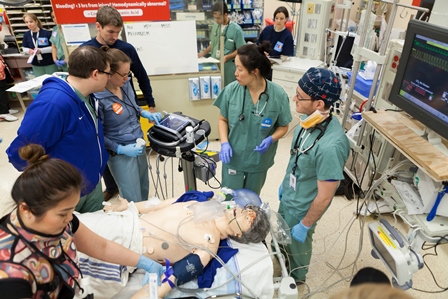The trauma bay in St. Michael’s Hospital Emergency Department bustled with activity as a new patient was rolled in on a stretcher. With a possible leg fracture and significant blood loss, X-rays were quickly ordered and the Massive Transfusion Protocol went into effect. Everyone performed as if a life were at stake.
The difference this time? The patient was a mannequin.
The exercise was the seventh of 12 in-situ ED simulations planned by Drs. Chris Hicks and Andrew Petrosoniak, emergency physicians and trauma team leaders who are co-principal investigators of the TRUST (Trauma Resuscitation Using in-Situ simulation Team training) study, which seeks to augment lecture-based and traditional simulation learning by observing how staff interact both with themselves and the actual ED environment, as well as how smoothly the hospital’s processes and systems work.
The simulation scenarios last 15-20 minutes and include any on-shift staff in the ED, as required. Each is based on actual critical events that happened at the hospital, but spun differently.
“It’s not anecdote driving change anymore,” said Dr. Hicks. “We’re able to produce evidence that substantiates what people already know – and some stuff that they didn’t know.”
But it isn’t just these combined observations and analyses inspiring recommendations for improvement, it’s the 20-minute debriefs after each simulation that provide the “invaluable feedback that can lead to change,” said Dr. Petrosoniak. “People feel like they have a voice and see the benefits for themselves, to their work flow, to the department and to the patients’ safety.”

Initially, staff seemed hesitant about adding more work to already busy days, but after a few sessions Dr. Petrosoniak noticed a “culture shift” toward patient safety and how to improve it systemically. Showing staff how their ideas effected change aided the buy-in of making simulations just another part of the day’s routine, said Dr. Hicks.
Changes to the hospital’s Massive Transfusion Protocol – a way of rapidly moving blood across the hospital – showcase the study’s success. Dr. Hicks said that while the protocol looked good on paper, all sorts of unanticipated challenges arose in the real world. Simple things like which route to take while transporting the blood, waiting for elevators and where to stand in the trauma bay all added up to precious time lost. Through the study’s analysis, the average delivery time was cut in half to about eight to nine minutes. This improvement exemplifies the difference between design and user experience, thereby showing the value of continued in-situ ED sessions.
“This is a study, but we hope this training becomes something that happens as a matter of routine,” said Dr. Hicks. “You do this to make yourself and your team do patient care better.”


